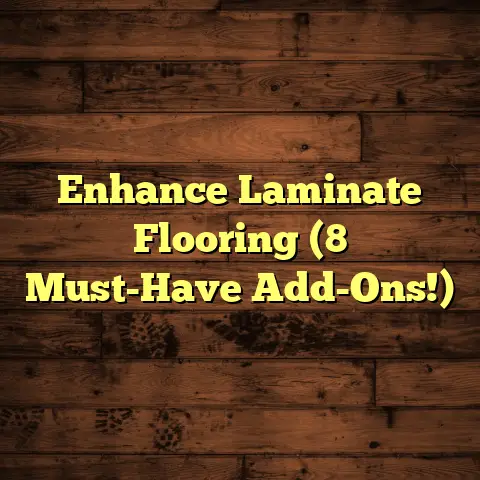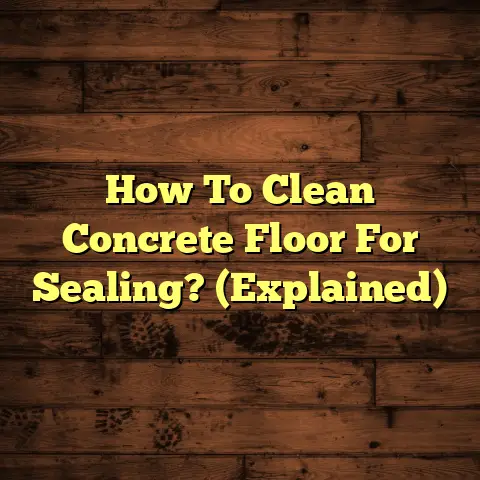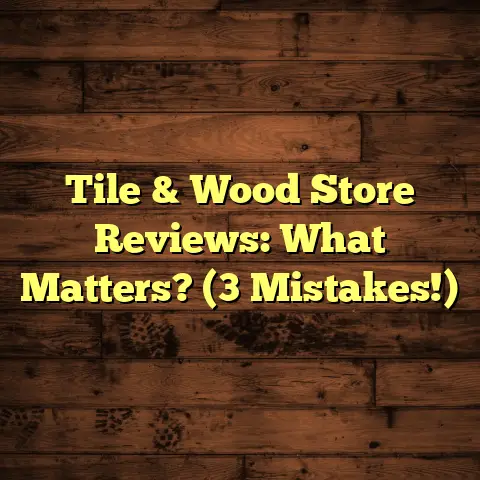Waterproof Laminate Vs Vinyl Plank? (1 Mistake!)
One Mistake!
Ever feel lost in the sea of flooring options? I get it.Choosing the right flooring can be tough, especially when you’re trying to balance looks, durability, and budget. Today, we’re diving deep into two popular contenders: waterproof laminate and vinyl plank.
But here’s the thing: most folks make one HUGE mistake when choosing between these two. Stick with me, and I’ll show you what it is and how to avoid it.
Introduction: The Importance of Layering
in Flooring Choices
Think of flooring like a cake. Each layer plays a vital role in the final product. You’ve got the base, the flavor, the frosting – all working together. Flooring is the same.
Most flooring materials are designed with multiple layers, each contributing to its performance, durability, and aesthetics. These layers work together to resist wear and tear, provide comfort underfoot, and look fantastic.
Understanding these layers is absolutely critical when deciding between waterproof laminate and vinyl plank. Why? Because the composition of each layer dictates how the flooring will perform in your home.
The biggest mistake I see homeowners make? They don’t consider how these layers impact the long-term performance of their chosen material. Let’s get into it!
Section 1: Overview of Waterproof Laminate
Flooring
Definition and Composition
So, what exactly is waterproof laminate? It’s a multi-layered synthetic flooring product designed to mimic the look of hardwood.
Let’s break down those layers:
-
Wear Layer: This is the top, transparent layer that protects against scratches, stains, and fading. A thicker wear layer generally means better durability.
-
Design Layer: This is a high-resolution photographic image that gives the laminate its wood or stone appearance.
-
Core Layer: This is the heart of the laminate, typically made of high-density fiberboard (HDF) that has been treated to resist water penetration.
-
Backing Layer: This bottom layer provides stability and helps prevent moisture from seeping up from the subfloor.
Now, the term “waterproof” is key here. Traditional laminate is not waterproof; it’s water-resistant at best. Waterproof laminate, however, has undergone innovations to truly repel water.
These innovations often involve special coatings, tighter seams, and improved core materials that minimize water absorption.
Benefits of Waterproof Laminate
Why choose waterproof laminate? Here are a few reasons:
-
Durability: It’s tough! The wear layer can withstand a lot of foot traffic and daily wear and tear.
-
Ease of Installation: Most waterproof laminate comes with a click-lock system, making it a DIY- friendly option. I’ve seen homeowners install entire rooms in a weekend!
-
Aesthetic Versatility: You can find waterproof laminate in a HUGE range of styles, colors, and textures. Want the look of rustic oak? Done. Prefer a sleek, modern gray? No problem.
-
Cost-Effective: Compared to hardwood, waterproof laminate is generally more budget-friendly.
Where does waterproof laminate really shine? Think kitchens, bathrooms, and entryways – areas where spills and moisture are common. I’ve even seen it used successfully in finished basements!
Limitations of Waterproof Laminate
Okay, let’s be real: waterproof laminate isn’t perfect. Here’s what you need to watch out for:
-
Susceptibility to Extreme Moisture: While it’s waterproof, extreme moisture can still be a problem. Think of a major flood or standing water for extended periods.
-
Importance of Correct Installation: This is HUGE. If the laminate isn’t installed correctly, water can seep in through the seams and cause warping or buckling. I’ve seen this happen way too often!
-
Not Always Repairable: If a plank gets damaged, you’ll likely need to replace the entire plank, which can be a hassle.
Section 2: Overview of Vinyl Plank Flooring
Definition and Composition
Now, let’s talk vinyl plank. Vinyl plank flooring is another synthetic flooring option designed to mimic the look of hardwood or stone.
Here’s the breakdown of its layers:
-
Wear Layer: Just like laminate, the wear layer protects against scratches, stains, and fading. The thickness of this layer is measured in mils (thousandths of an inch). A thicker wear layer equals greater durability.
-
Design Layer: Again, this is a high-resolution photographic image that provides the visual appeal.
-
Core Layer: This is where things get interesting. The core of vinyl plank is typically made of PVC (polyvinyl chloride) or WPC (wood plastic composite) or SPC (stone plastic composite).
-
Backing Layer: This layer provides stability and cushioning.
It’s important to distinguish between luxury vinyl tile (LVT) and standard vinyl planks. LVT is generally thicker and more durable, with a more realistic look and feel. I often recommend LVT for high-traffic areas.
Benefits of Vinyl Plank Flooring
Why is vinyl plank so popular? Here’s why:
-
High Water Resistance: Vinyl is inherently water- resistant, making it an excellent choice for moisture-prone areas.
-
Comfort Underfoot: Vinyl has a bit of give, making it more comfortable to walk on than harder surfaces like tile or laminate.
-
Sound Absorption: Vinyl helps to dampen sound, which can be a big plus in apartments or homes with kids.
-
Easy to Clean: Vinyl is super easy to clean – just sweep and mop!
Vinyl plank excels in basements, laundry rooms, and bathrooms – places where water is a constant concern. I’ve even seen it used in commercial settings with great success.
Limitations of Vinyl Plank Flooring
Like any flooring material, vinyl plank has its drawbacks:
-
Potential Issues with Fading: Prolonged exposure to direct sunlight can cause vinyl to fade over time. Using window treatments can help mitigate this.
-
Necessity of Acclimation: Vinyl needs to acclimate to the room’s temperature and humidity before installation. Failing to do so can lead to buckling or gapping.
-
Can Be Damaged by Sharp Objects: While durable, vinyl can be scratched or gouged by sharp objects. Use furniture pads to protect your floors.
Section 3: Comparing Waterproof Laminate and
Vinyl Plank Flooring
Okay, let’s get down to brass tacks. How do waterproof laminate and vinyl plank stack up against each other?
Performance in Moisture-Prone Areas
This is a big one. Both materials are designed to handle moisture, but there are subtle differences.
Waterproof laminate relies on a water-resistant core and tight seams to prevent water penetration. However, if water manages to seep through, the core can swell and cause damage.
Vinyl plank, on the other hand, is inherently water- resistant due to its PVC or WPC/SPC composition. This makes it a more reliable choice for areas that are frequently exposed to water.
I’ve seen both materials perform well in bathrooms, but I generally recommend vinyl plank for bathrooms with heavy use or for homes with pets.
Aesthetic Options
Both waterproof laminate and vinyl plank offer a wide range of aesthetic options. You can find them in various colors, textures, and patterns, mimicking the look of hardwood, stone, or tile.
The design layer plays a crucial role in achieving realistic looks. High-quality laminate and vinyl plank use advanced printing techniques to create incredibly convincing visuals.
I’ve seen some vinyl planks that are virtually indistinguishable from real hardwood! The key is to look for products with textured surfaces and realistic grain patterns.
Installation Process
Both waterproof laminate and vinyl plank are relatively easy to install, especially compared to traditional hardwood or tile.
Most products feature a click-lock system, which allows you to simply snap the planks together. However, there are some differences to consider.
Laminate typically requires an underlayment to provide cushioning and sound insulation. Vinyl plank may or may not require an underlayment, depending on the product.
I always recommend following the manufacturer’s instructions carefully, regardless of which material you choose. Proper subfloor preparation is also essential for a successful installation.
Cost Analysis
Cost is always a factor. Here’s a general breakdown:
-
Initial Purchase Price: Waterproof laminate and vinyl plank are generally comparable in price, ranging from \$2 to \$7 per square foot. However, prices can vary depending on the quality, brand, and style.
-
Installation Costs: If you’re hiring a professional installer, labor costs can range from \$2 to \$5 per square foot. DIY installation can save you money, but it requires time and effort.
-
Long-Term Maintenance Expenses: Both materials are relatively low-maintenance. Regular sweeping and mopping are usually all that’s needed. However, you may need to replace damaged planks over time.
In the long run, vinyl plank may be slightly more durable and require fewer repairs, but the difference is often negligible.
Section 4: The One Common Mistake When Choosing
Between Waterproof Laminate and Vinyl Plank
Alright, here it is: the one mistake I see homeowners make all the time…
Identifying the Mistake
The biggest mistake? Overlooking the importance of the core layer’s composition in relation to your specific needs.
I know, it sounds technical, but it’s crucial.
The core layer is the heart of the flooring. It determines how well the flooring will resist water, withstand impact, and maintain its shape over time.
Explaining the Implications
Here’s why this oversight can be so problematic:
-
Longevity: A poorly chosen core can lead to premature failure of the flooring, requiring costly repairs or replacement.
-
Water Resistance: If the core isn’t truly waterproof, it can swell, warp, or delaminate when exposed to moisture.
-
Overall Performance: The core affects everything from how the flooring feels underfoot to how well it dampens sound.
Let me give you an example. I had a client who installed waterproof laminate with an HDF core in their basement bathroom. They thought they were making a safe choice because it was labeled “waterproof.”
However, after a minor plumbing leak, the laminate started to swell and buckle. The HDF core, while treated to resist water, couldn’t handle prolonged exposure. They ended up having to replace the entire floor.
If they had chosen vinyl plank with a WPC or SPC core, they likely would have avoided this problem.
Conclusion: Making an Informed Decision
Choosing between waterproof laminate and vinyl plank doesn’t have to be a headache. By understanding the layered construction of each material and considering your specific needs, you can make an informed decision that you’ll be happy with for years to come.
Remember, the core layer is key! Don’t overlook its importance.
Before you make a final decision, ask yourself these questions:
-
Where will the flooring be installed?
-
What is the moisture level in that area?
-
What is the expected foot traffic?
-
What is my budget?
By answering these questions and doing your research, you can avoid the common mistake and choose the perfect flooring for your home.
Happy flooring!





